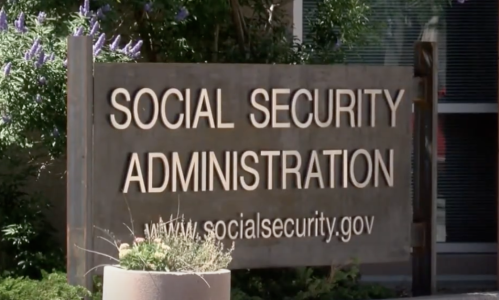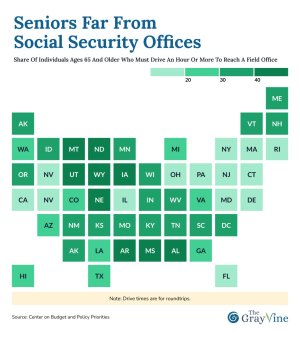Is your area making it harder for seniors to access Social Security? Find out where travel times are the worst
- Replies 0
If you’ve ever had to wrangle with the Social Security Administration (SSA), you know it’s rarely a walk in the park.
But for millions of older Americans, a new policy is about to make that journey—quite literally—a lot longer. Here at The GrayVine, we’re all about keeping you in the know, especially when it comes to the systems you rely on.
So, let’s take a closer look at how a recent SSA rule change could mean more time on the road, more time in waiting rooms, and more headaches for seniors across the country.
A New Rule, A New Roadblock
The SSA recently rolled out a policy that’s expected to send nearly 2 million more people to their local Social Security offices every year.
Why? In an effort to crack down on direct deposit fraud, the agency now requires most beneficiaries to show up in person to change their bank information—unless they can navigate the online system or use their bank’s automatic enrollment (and not all banks play ball).
On paper, it sounds like a reasonable step to protect your hard-earned benefits.
But in practice, it’s a logistical nightmare for many, especially those who live far from the nearest SSA office or who aren’t comfortable with online tools.

How Far Is Too Far? The Numbers Tell the Story
According to a new analysis from the Center on Budget and Policy Priorities (CBPP), nearly one in four seniors lives more than an hour’s drive from their local Social Security field office.
And that’s without factoring in traffic, weather, or the time it takes to find parking and get through security. For half of all seniors, the trip is at least 33 minutes each way.
Let’s put that in perspective: The policy change is expected to add more than 1 million hours of travel time per year for older Americans. That’s a lot of time that could be spent with grandkids, volunteering, or simply enjoying retirement.
Where the Road Gets Longest: States with the Toughest Access
If you’re in a rural or less-populated state, the odds are even worse. In Arkansas, Iowa, Maine, Mississippi, Montana, Nebraska, North Dakota, South Dakota, Vermont, and Wyoming, more than 40% of seniors face drives of over an hour to reach their local SSA office.
In earlier news: Backtracked: Government agency reverses course on service cutbacks following media report
In another 21 states—including Alabama, Alaska, Arizona, Georgia, Idaho, Indiana, Kansas, Kentucky, Louisiana, Minnesota, Missouri, New Hampshire, New Mexico, North Carolina, Oklahoma, Oregon, South Carolina, Tennessee, West Virginia, Wisconsin, and Virginia—between 25% and 39% of seniors are in the same boat.
Even in more urbanized states, if you don’t live near a field office, you could be looking at a significant trek. And let’s not forget: About 6 million seniors don’t drive at all, and nearly 8 million have a medical condition or disability that makes travel difficult.
Why the Change? The Fraud Factor
The SSA says the new policy is all about fighting fraud. Since 2023, the agency has seen a spike in attempts to redirect Social Security payments to fraudulent accounts, especially via phone calls.
In just one month this spring, enhanced fraud protections flagged over 20,000 suspicious direct deposit requests. The agency estimates these measures have already prevented nearly $20 million in losses.
But critics argue the policy is a sledgehammer for a problem that might only need a scalpel.
According to the CBPP, only about 2,000 beneficiaries had their direct deposits redirected last year, and just 800 of those cases involved phone fraud. That’s a far cry from the 2 million people now being asked to make in-person visits.
Navigating the New System: What Are Your Options?
If you need to change your direct deposit information, here’s what you’re up against:
Related story: New rules ahead: What Social Security just announced may affect your plans
The Hidden Costs: Time, Energy, and Frustration
The CBPP’s analysis doesn’t even account for the time spent scheduling appointments, waiting in line, or dealing with understaffed offices. The SSA has cut about 7,000 employees in recent years, leading to longer waits and more frustration for everyone.
And while there were rumors that the SSA might close some field offices to save money, the agency says that’s not happening—at least for now. Still, with fewer staff and more in-person visits, the system is under strain.
Read next: Changes at Social Security: What recent updates could mean for your benefits

Have you had to make a long trip to your local Social Security office? Did you run into roadblocks with the new direct deposit rules? Or do you have tips for making the process easier? Share your stories and advice in the comments below!
But for millions of older Americans, a new policy is about to make that journey—quite literally—a lot longer. Here at The GrayVine, we’re all about keeping you in the know, especially when it comes to the systems you rely on.
So, let’s take a closer look at how a recent SSA rule change could mean more time on the road, more time in waiting rooms, and more headaches for seniors across the country.
A New Rule, A New Roadblock
The SSA recently rolled out a policy that’s expected to send nearly 2 million more people to their local Social Security offices every year.
Why? In an effort to crack down on direct deposit fraud, the agency now requires most beneficiaries to show up in person to change their bank information—unless they can navigate the online system or use their bank’s automatic enrollment (and not all banks play ball).
On paper, it sounds like a reasonable step to protect your hard-earned benefits.
But in practice, it’s a logistical nightmare for many, especially those who live far from the nearest SSA office or who aren’t comfortable with online tools.

A new Social Security policy in the US will require nearly 2 million more people each year—many of them seniors—to visit local offices in person to change their direct deposit details, leading to increased travel times and inconvenience. Image source: KRQE.
How Far Is Too Far? The Numbers Tell the Story
According to a new analysis from the Center on Budget and Policy Priorities (CBPP), nearly one in four seniors lives more than an hour’s drive from their local Social Security field office.
And that’s without factoring in traffic, weather, or the time it takes to find parking and get through security. For half of all seniors, the trip is at least 33 minutes each way.
Let’s put that in perspective: The policy change is expected to add more than 1 million hours of travel time per year for older Americans. That’s a lot of time that could be spent with grandkids, volunteering, or simply enjoying retirement.
Where the Road Gets Longest: States with the Toughest Access
If you’re in a rural or less-populated state, the odds are even worse. In Arkansas, Iowa, Maine, Mississippi, Montana, Nebraska, North Dakota, South Dakota, Vermont, and Wyoming, more than 40% of seniors face drives of over an hour to reach their local SSA office.
In earlier news: Backtracked: Government agency reverses course on service cutbacks following media report
In another 21 states—including Alabama, Alaska, Arizona, Georgia, Idaho, Indiana, Kansas, Kentucky, Louisiana, Minnesota, Missouri, New Hampshire, New Mexico, North Carolina, Oklahoma, Oregon, South Carolina, Tennessee, West Virginia, Wisconsin, and Virginia—between 25% and 39% of seniors are in the same boat.
Even in more urbanized states, if you don’t live near a field office, you could be looking at a significant trek. And let’s not forget: About 6 million seniors don’t drive at all, and nearly 8 million have a medical condition or disability that makes travel difficult.
Why the Change? The Fraud Factor
The SSA says the new policy is all about fighting fraud. Since 2023, the agency has seen a spike in attempts to redirect Social Security payments to fraudulent accounts, especially via phone calls.
In just one month this spring, enhanced fraud protections flagged over 20,000 suspicious direct deposit requests. The agency estimates these measures have already prevented nearly $20 million in losses.
But critics argue the policy is a sledgehammer for a problem that might only need a scalpel.
According to the CBPP, only about 2,000 beneficiaries had their direct deposits redirected last year, and just 800 of those cases involved phone fraud. That’s a far cry from the 2 million people now being asked to make in-person visits.
Navigating the New System: What Are Your Options?
If you need to change your direct deposit information, here’s what you’re up against:
- Online: You can log into (or create) a My Social Security account and get a one-time code before calling the SSA’s 800 number. But for many, especially those without reliable internet or who aren’t tech-savvy, this isn’t realistic.
- In-Person: If you can’t use the online system, you’ll need to visit your local field office. Appointments are encouraged, but walk-ins are allowed. Be prepared for long waits—only 43% of people get an appointment within 28 days.
- Through Your Bank: Some banks offer automatic enrollment for Social Security direct deposit, but not all do. Check with your financial institution to see if this is an option.
Related story: New rules ahead: What Social Security just announced may affect your plans
The Hidden Costs: Time, Energy, and Frustration
The CBPP’s analysis doesn’t even account for the time spent scheduling appointments, waiting in line, or dealing with understaffed offices. The SSA has cut about 7,000 employees in recent years, leading to longer waits and more frustration for everyone.
And while there were rumors that the SSA might close some field offices to save money, the agency says that’s not happening—at least for now. Still, with fewer staff and more in-person visits, the system is under strain.
Read next: Changes at Social Security: What recent updates could mean for your benefits
Key Takeaways
- A new Social Security policy in the US will require nearly 2 million more people each year—many of them seniors—to visit local offices in person to change their direct deposit details, leading to increased travel times and inconvenience.
- Almost a quarter of seniors live over an hour away from the nearest Social Security office, and in 31 states, more than 25% of seniors face long travel times for in-person visits.
- The policy is aimed at reducing direct deposit fraud, but advocates argue the scale of fraud doesn’t justify the burden placed on millions of elderly and disabled people, many of whom don’t drive or have trouble travelling.
- The move comes at a time when Social Security offices are understaffed and appointment wait times are long, making it even harder for vulnerable people to access the services they need.
Have you had to make a long trip to your local Social Security office? Did you run into roadblocks with the new direct deposit rules? Or do you have tips for making the process easier? Share your stories and advice in the comments below!







